ASUS Zenbook (UX21) Review
by Anand Lal Shimpi on October 22, 2011 8:00 PM ESTThe Display
To hit a $999 price point with the hardware that it has, ASUS (like Apple) had to give up the pursuit of an IPS panel in the Zenbook. As we saw with the MacBook Air however, it is quite possible to select a decent TN panel at this price point. Was ASUS able to? Sort of.
In the interest of beating Apple, ASUS pursued a brighter overall display design. ASUS even selected a new optical film for the Zenbook's panel that helps improve brightness. As a result, the Zenbook UX21 is brighter than the 11-inch MBA. Given the sad state of most PC notebook displays, the Zenbook fares very well when compared to its PC brethren as well. Very few PC displays are as bright as what we saw with the Zenbook. In fact, a quick look at our PC notebook Bench database reveals the Zenbook is the brightest PC notebook we've ever tested.
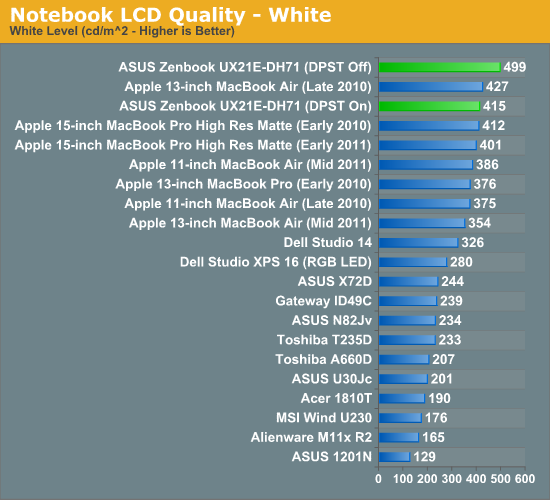
The brightness does come with a downside: higher than desirable black levels. The lowest black level I measured on the UX21 was 1.1 nits using our X-rite i1Display 2, however in the center of the display I measured 1.20 nits. This is nearly double the value I recorded on the 11-inch MacBook Air. Although not terrible, the black levels on the Zenbook's panel could use some improvement. Note that these results were generated with Intel's DPST (Display Power Savings Technology) enabled. Without DPST enabled, the black levels jump even higher to 2.7 nits in our test, while the white point makes it to just under 500 nits. Contrast ratio actually goes down since the impact on black levels is greater than the increase in white point brightness. ASUS ties DPST state to power mode; it's enabled in High Performance mode (on AC power) but disabled in Battery Saver mode (on DC power). You can override these settings by manually configuring the power plan in the Windows 7 control panel.
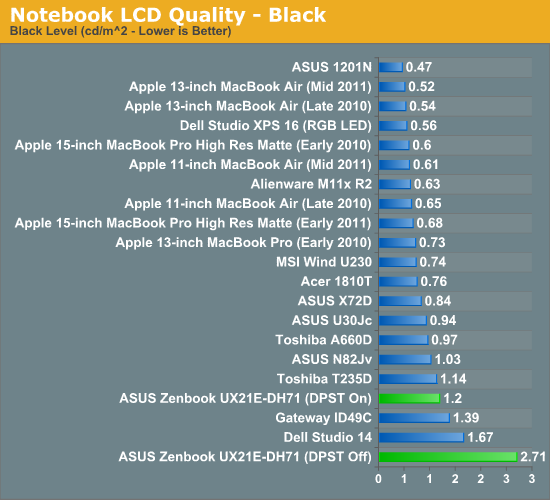

ASUS sent along test data that showed its black levels were only around 40% higher than the 11-inch MBA; however, after a couple of nights of trying I couldn't get any better than the numbers I've presented here. ASUS does use a more sophisticated colorimeter, but its test data for the MacBook Air seems to match up with mine whereas its Zenbook data is considerably better than what I have here.

ASUS' Display Test Data
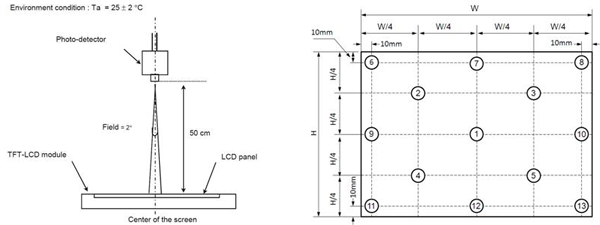
It's possible I simply received a bad unit, or perhaps I just lost the panel lottery with the UX21, but I can only report on the data I was able to generate. The Zenbook UX21's display is very bright, but it neeeds better black levels.
In terms of color quality and gamut, the Zenbook is very competitive once calibrated. You get better color gamut than a MacBook Air and comparable color accuracy. However, the out of the box calibration isn't all that great, as ASUS doesn't calibrate white to 6500K at the factory (it's set to 7700K by default). The system does ship with a digital color management system called Splendid, but you don't have many options beyond moving RGB or color temperature sliders. If ASUS wants to compete in this space I do believe it needs to calibrate panels at the factory.
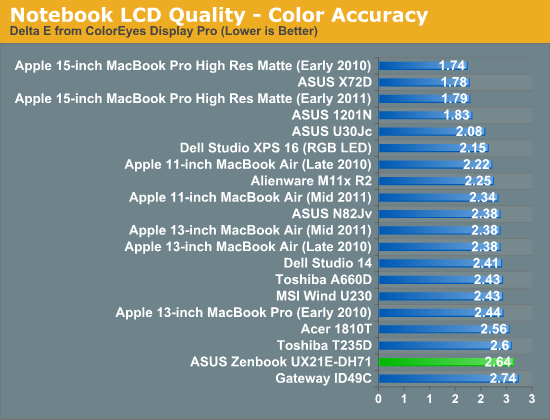
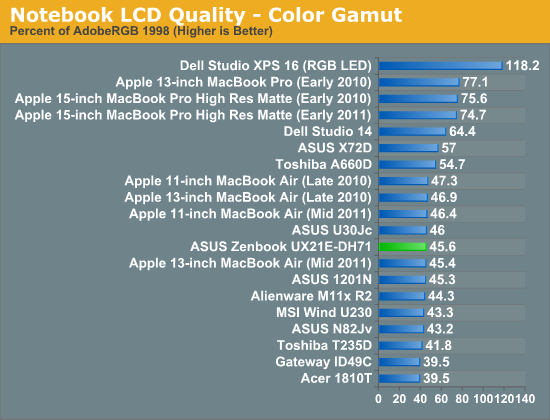
Viewing angle is my only other complaint about the UX21's panel. It seems as if in the quest for better specs, ASUS didn't pay enough attention to viewing angles. Although the UX21 uses a TN panel it is possible to improve viewing angle through the use of a compensation film in front of the polarizer in the display stack. Most TN panels are paired with some form of wide viewing angle film to improve their characteristics, but Apple actually uses an extra wide view compensation film in the case of the MacBook Air to give it slightly more IPS-like viewing angles. The downside to using this film is it reduces light output, which in turn improves black levels (peak contrast ratio is generally unaffected since you clip both white and black levels).
ASUS opted against using the same EWV film as Apple, in part to improve overall brightness as well as guarantee a little bit of off-angle privacy. While the result is a brighter display than what Apple was able to accomplish, the UX21 is far more sensitive to viewing angles. As you can see in the shots below, the UX21 looks great straight on but anything off center is significantly worse. In most situations I didn't find this to be a huge problem as I was able to tilt the display a little farther back and prevent the display from getting too washed out.
Overall the display is better than the vast majority of what you find on PC notebooks, however a couple of key decisions kept ASUS from making it perfect. I have already fed my test data and suggestions back to ASUS engineering, who are currently evaluating options for the second generation UX series next year.
















109 Comments
View All Comments
DanNeely - Sunday, October 23, 2011 - link
After my pata HDD decomissioning project I ended up with several sets containing torx bits. I started out with a large set of sears bits that included some torx ones I originally bought for other uses; added a set of 1/4" socket wrench style torx bits from an autozone because my sears set didn't go to anything smaller, and finally ended up ordering a set of mini bits from amazon after discovering I needed an even smaller size to crack open a few of the laptop drives.krumme - Sunday, October 23, 2011 - link
Lets pretend this can play 1080 flash videoLets pretend this is for all day computing
Lets pretend all those BM have anything to do with real world usage pattern
Lets pretend this will sell
ARM15 and win 8 will end all the wet dreams that is left if it matter now it will not sell, and if you dont need the 28nm powerhouse of a bobcat AMD derived core.
This looks more like a comercial to me than a review. This is more stupid than a BD for desktop.
morousg - Sunday, October 23, 2011 - link
I guess the legal battle will beguin soon. This is a perfect copy of fabrication processes, chassis dessing and even component selection and component placement inside the "CopyAir".They are copying even almost the price!!
There are slight differences on I/O ports and the back color of the screen, but the ventilation system is also copied. It's the first PC I've ever seen copying the entire form factor and design from a Mac. The HP Envy line of PC's where very similar to MacBook Pros, but almost where made of plastic, and there where more differences. This time, it's every thing!!
The battery is divided and disposed sa in the Macbook Air, and it occupies a similar proportion of space.
The SSD has the same form farctor.
The trackpad, is almost as big as the Macbook Air's.
The screen even has a black edge, just to don't confuse you to think this is not a copy.
Even the rubber around the age of the screen, is the same.
And of course, as Apple does and so proudly exposes, Asus has taken a solid block of aluminum, and craved it to make a copy of the Apple's Unibody notebook chassis.
You know what? Even the charger has a very similar shape.
Is there any body able to create something new instead of always copying Apple??
Roland00Address - Sunday, October 23, 2011 - link
Let sue the bread companies for their bread is almost virtually identical to the almighty wonder bread.morousg - Monday, October 24, 2011 - link
Let's say I have a patent about bread fabrication that makes my bread able to be preserved in a certain manner and do a certain final process in any bakery or even supermarket in a fast and cheap way.Let's say no one else (until I patented it) has done it before (in real life not in movies...) and I spent time and a suffered big amount of bucks to develop that process.
Now, some on else copy it for free.
If it where legal, we would provably still fight with rocks, because no body would invest on R+D. Don't forget the D, from Development. This is a costy part, from ideas to reality. There are lots of try-and-error steps, that consume worker hours and material. No body should dismiss that in the name of progress.
And now, ask your self why oh why the bread is so cheap. Because it has always been? Think again.
karlostomy - Monday, October 24, 2011 - link
morousg says "Is there any body able to create something new instead of always copying Apple?? "No offence, but that is just nonsense.
http://www.youtube.com/watch?v=CW0DUg63lqU
http://www.youtube.com/watch?v=CW0DUg63lqU
http://rocketsandrayguns.tumblr.com/post/399321220...
Of course, this is just the tip of the iceberg that you seem to be blissfully unaware of.
How strange that you have been brainwashed to think other companies copy apple, when in the reverse is evidently true.
morousg - Monday, October 24, 2011 - link
Thank you for the links. They where enlightening.But you, as many others, are missing "one more thing". The Development of the ideas.
Having ideas is a fun thing to do. Any one can do it, mixing other ideas, changing them a bit etc… But few are so brave to try to do things (maybe the same things) but in a new way, or with something that no one has ever DEVELOPED.
Trying to DEVELOP a new feature that erases others that are more or less well stablished (like the stylus or the notebook million pieces typical PC structure) is risky and costly. Few business do that, or if they do, the first failure makes them stop or reduce their efforts on R+D.
That's the good thing from Apple, they never stop trying, even if they do some mistakes. Is good that someone invests in creating new thigs, or imporving existing things in a way that they seem completely new, because they have something much better and unique (again unique in the sense of being the first to develop it).
So I think that is a good thing that a business that believes in R+D, tries to protect their investments in both R+D.
I fact, probably, during the D part you are creating something new, like a fabrication process. A notebook is a notebook. But a traditional notebook chassis is definitely not a unibody chassis, and the technology involved is definitely not the same.
Why should I spend money and time on trying to improve things, if others will copy my improvement or invention, and I won't get any benefit from the investment I did?
Patents exist to protect PROGRESS, that is quite much more than just having nice ideas, and putting them on a movie.
Sunburn74 - Sunday, October 23, 2011 - link
What tradeoffs are people complaining about? All of these parts are parts found in lots of other notebooks out there. The only actual tradeoff I see here is the battery life for form factor trade.Those of you who are asking for HD screens, IPS panels, thunderbolt connectors, external gpus, and etc should realize Asus makes laptops for everyone, not just the 1% who know what an external gpu is. If you are one of those people asking for these things, be told very clearly now, you are in the <1% of people could care, could use, know how to use, and would actually use these things. The rest of us are perfectly happy working on our TN panels at 1366x766 surfing the web, checking email, typing up word documents, talking via skype with our webcams, and enjoying our beautiful form factor PC. We don't care about benchmarks when it comes to laptops, how many gflops my processor does or how many FPS my laptop gets in Civ 5. We care about how much fun it actually is to use the damn thing. My PC desktop screams, absolutely screams, but when it comes to laptops thats the only thing I care about and I'm as close to a normal person as you're gonna get on this forum. Done are my days of lugging around a 17in beast of a powerhouse laptop that was embarassing to pull out when all I wanted to do was check an email at the airport or write a quick note. All I care about now is how fun and easy and reliable the laptop is to use for my simple daily tasks. This represents the viewpoint of most people. If you disagree you are a moron because its that exploiting that very same viewpoints that has propelled apple to where they are today. Apple doesn't make the products with the most badass hardware. They make the products that are the most badass to actuall use.
There are niches to laptops. Don't forget that. There are gaming laptops, there are pro/workstation laptops, there are ultraportables, and there are now ultrabooks (a refinement, be it more expensive refinement) of the ultraportable. Understand that, get a girlfriend, and shut up.
madmark4 - Thursday, November 3, 2011 - link
Yes, exactly.If you want a laptop to replace your gaming desktop rig, this isn't for you.
If you want something you can actually CARRY WITH YOU, and want to take on a plane, or even just drop in a bag for a trip to the coffee shop, this is nearly a perfect machine.
I have an HP Elitebook 8440W with quad core i7, 8gb ram, and two hard drives. It has a 14" screen, and is smokin fast.
It sits at home, whenever I go somewhere, because it also weighs 7 pounds, gets about 3 hours of battery life (which requires extra weight carrying the charger everywhere) and won't fit in something the size of a mailing envelope.
I should also note that 1) no one but apple does anything with Thunderbolt. and 2) all those extra features mean higher costs. Would this be your 'ideal' laptop if it was twice as thick, weighed twice as much, and cost 700$ more because it had an IPS screen, thunderbolt, another USB 3 port, and a docking station plug? If so, they already make those, its called an HP Elitebook 8440W.
My primary goal in a laptop is to get something that is fast enough to run what I want to run, even if it isn't the fastest at it, but it needs to do that while being portable enough that I will actually take it with me TO run those things. Ease of use and portability are worth more to me than an external GPU plug. I'm not buying this intending to run COD3 on it. I'm buying it to surf, run eclipse for programming jobs, use Word/Excel, and otherwise be productive.
shompa - Sunday, October 23, 2011 - link
This machine is silicon art, just like the Macbook Air.I wish that Asus supported thunderbolt. With Apples thunderbolt display you get a complete setup, something that Asus can't deliver.
Thunderbolt --> USB/Firewire and gigabith ethernet. All in just one cable.
When will BIOS die? UEFI have been around for 10 years. Why play around with a 1970 technology?
With PCI-E thunderbolt cases. You can buy an macbook air and connect the latest AMD/Nvidia graphic card to it an play games.
The only reason you should buy this product instead of Apple is if you hate Apple and want a couple % better speed. The reason why you should buy Apple is that you get world class support, can use both Windows and OSX, thunderbolt, rapid start, iCloud, Ilife and so on.